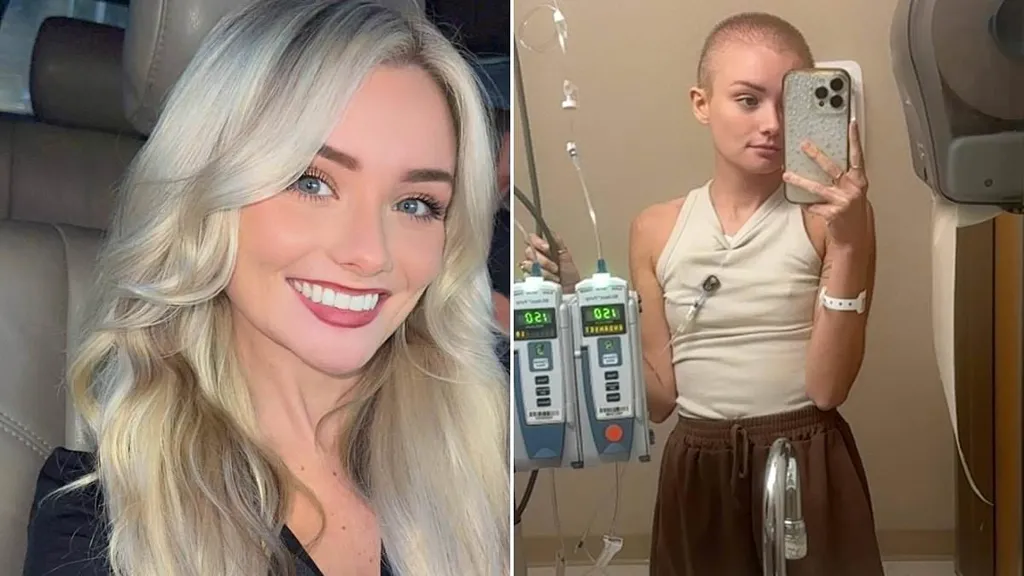At just 25 years old, Savannah Caldwell had her whole life ahead of her.
The Kentucky native was healthy, active, and cherished time with her friends and the four stepchildren she helped raise.
But when she began experiencing persistent exhaustion and aching bones, she turned to doctors for answers.
Physicians initially denied her tests saying she was 'too young for cancer', but after a lump was found on her chest they hey agreed to run further tests, and a biopsy was performed.
Days later, she was diagnosed with stage four breast cancer that had spread to her ribs, spine, lungs, and possibly her skull. Doctors gave her just a 32 percent chance of surviving the next five years.
'I was in complete shock. I remember staring at the floor not knowing what to think, not knowing what was next, that was a big worry.
'I've had to grow up faster in a week than I have in 25 years.'
Caldwell is just one of the ever-increasing number of women diagnosed with breast cancer before they turn 50, which is now among the fastest growing cancers in the age group alongside colon cancer.
Researchers say breast cancer cases among young women are now rising by up to 1.85 percent per year, with an extra 4,000 women being diagnosed with the cancer annually in the US compared to a decade ago.
While breast cancer in women in their 20s is rare, it's not unheard of. About 6.5 out of every 100,000 women in their 20s will receive a breast cancer diagnosis, according to the American Cancer Society
They remain puzzled by the surge, especially in healthy, young individuals, though some have pointed to possible environmental triggers or earlier onset of puberty as potential factors.
For Caldwell, who is from Russell,the diagnosis came with devastating physical symptoms.
Shortly after learning she had stage four breast cancer, the 25-year-old developed crippling back pain caused by a tumor pressing against her spine.
The pain became so severe it made walking and even basic movement difficult.
Doctors immediately began an aggressive treatment plan, starting with 12 rounds of chemotherapy.
Caldwell has already completed nine and may also undergo immunotherapy and radiation depending on how her body responds.
Revealing her story to local news station WSAZ , she said: 'At night, especially when with my kids, whenever we cuddle up... I look over... and I just hope I get to see them grow up.
'Things change minute-by-minute, but for the most part I am being very optimistic. I hope my will to fight can get me through.
'I want to fight, I want to live and I want my story to be a beautiful one no matter how long or short it is.'
Caldwell said the chemotherapy has gone well so far, but that she has started to lose her hair and has been losing weight rapidly, now being down to 88lbs.
In an update after her fourth round of chemotherapy in June, she said: 'Between the third and fourth chemo a lot has changed.
'My hair is thinning a lot; just yesterday I noticed it is coming out in clumps. I am still experiencing a lot of back pain, neck pain, [pain] in my ribs.
She added: 'I look forward to getting this over with, and getting through.'
After the ninth chemotherapy, she said she was 'still not sleeping much' but 'hanging in there'.
Doctors have diagnosed her with invasive ductal carcinoma, the most common form of breast cancer and behind about 80 percent of all cases.
Her friends have started a fundraiser online to raise money to help cover bills and complications linked to the chemotherapy.
On the page, they write: 'Savannah is not going to be able to work for a long time. Please help her fight this beast.'
Research published earlier this year that analyzed 2.1million cases of early-onset cancer diagnosed between 2010 and 2019 found breast cancer, thyroid cancer and melanoma were the fastest rising among young women.
Among young men, colon cancer, testicular cancer and melanoma were the most likely to be diagnosed before someone turned 50 years old.
Doctors have also suggested that a trend toward having a first child at a later age could be a possible explanation for the rise in diagnoses.
